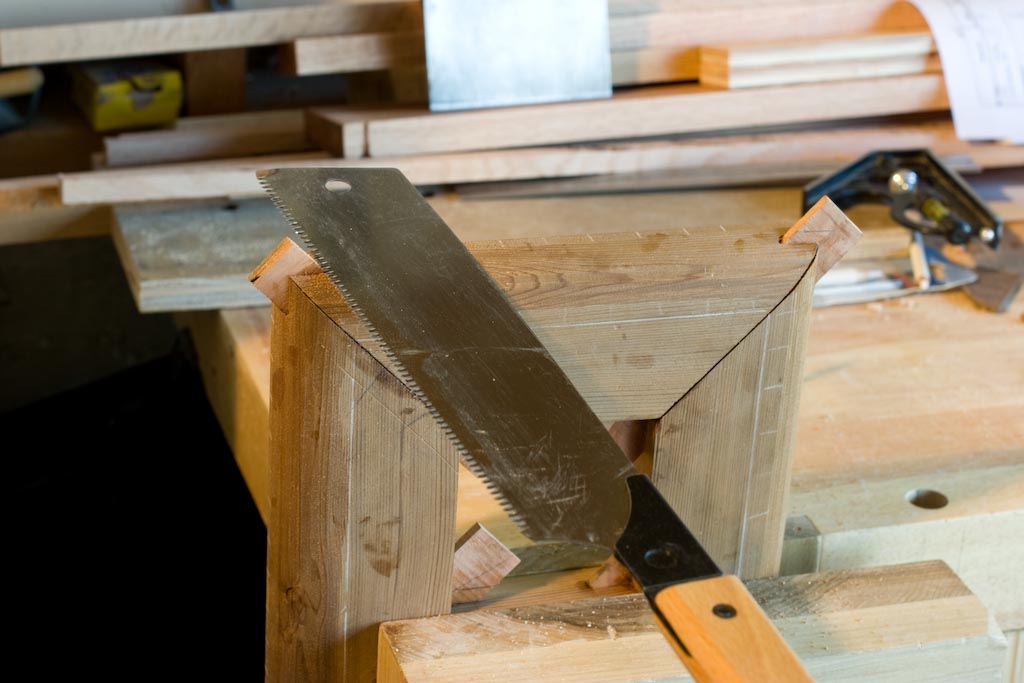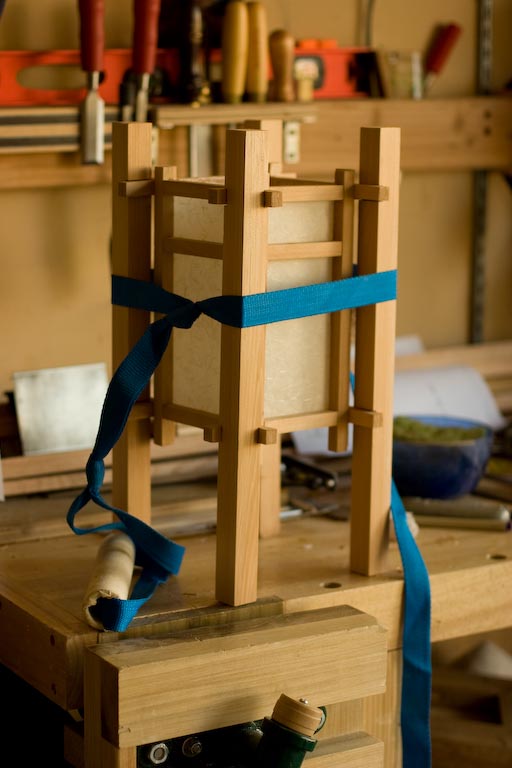Ok, these guys are just showing off, but I guess that is the nature of a competition.

Japanese hand plane competition
Ok, these guys are just showing off, but I guess that is the nature of a competition.

Japanese hand plane competition
I’ve been wanting to make some of my own tools for a while now.
To that end, I’ve been working on a walnut handled square for quite some time. I now agree with most of the bloggers out there that most engineer’s squares, like you can find at the home centers are crap. Drop them a couple of times, and they go out of square. Framing squares on the other hand are almost indestructible and just as cheap. So, why not put a wood wrapper around a smaller framing square? This is my attempt.
The first step was to saw a wide kerf, with one of the recently refurbished 5tpi rip saw, and then finish it off with some sanding.
Then keep sanding until it fits. Then Epoxy it in place.
Then square it up by a combination of a plane and sandpaper mounted on a flat surface (planed 2×4 in my case). Once square, more epoxy for a brass rubbing plate, another square check and some cleanup.
Next up, I managed to make a marking guage in less than 2 days! From scrap wood!
First, I tried to make a channel for the screw with the routing plow plane, between to pre-drilled holes. No Bueno. The routing plane can’t start and stop in a short distance. I ended up just creating a shallow dish.
On to the more usual approach – rip cut some strips, and then glue in some spacers.
Despite being about an inch wide, the channel in the mating piece was pretty easy with the routing plane. So was roughing our the shape with the coping saw, files and 60 grit sand paper.
The problem was drilling the holes for the inserts. I must need to sharpen my drill bits or do something different. On both holes – oh yea, planning is important too; I had tear out on the top, and tear-out on the bottom (despite having a backing piece in place). Notice the nice big chunk that tore out between the two holes on the top (the chunk itself is sitting in far right of the picture above).
Steve Emmons has a video posted, where he makes essentially the same style guage, but with a different shape for the lower piece – using power tools. One thing I did learn from the video was how to properly install an insert – use a screw inside the insert, instead of the slots. No wonder I bent the slots the first few times I tried to do an insert.
The other problem with the inserts is that the manufacturer recommended a 3/8″ hole, which worked fine in the test hole I tried in pine, but failed miserably in the walnut. Luckily, by the time I did the 2nd hole, I found I had a 13/32″ drill bit, which worked much better.
The wood whisperer has had good luck with just tapping threads into the wood. I think I might have to try this approach next time.
A little bit of boiled linseed oil, and then some wax for the sliding faces, et voila!
I have yet to use either tool on a real project yet. I’ll have to see how they work out.
Lessons Learned:
Last weekend, the neighbor’s 4yr old got curious about the workbench and all the tools, pulling them out one after another (usually the sharp ones) and immediately brandishing them against the bench.
I did what I could to keep up, but by the time the other two boys showed up, and we started making swords, it started getting a little chaotic. Good times.
I’ve had some aspen drying out for several years now, most of which went into making the (sitting) bench a while back, but there were a few scrap branches (aka reaction wood) left over. Curious thing: apparently as the bark dehydrated and sunk in close to the branches, the sap started getting squeezed out, and then hardened into these orage whisker things.
Russ
Becky’s dad was kind enough to give me three old saws, and then I found 2 more for $5 each at the Longmont indoor flea market.
So step one, was rust removal (using electrolysis). However, after 3 saws, I ended up just using brasso polish and sandpaper – which seemed to do OK too. I think the electrolysis approach might have worked better if I had a beefier power supply, neither of the supplies I had would do even 1 Amp at 12V. The best I could do was with the 6V, 5A supply, which ended supplying more like 5V at 5A.
Some saws came out better than others.
I think this was one of the newer ones, and it came out pretty darn good. You can see that it is almost as shiney along the length of the blade as it is under the handle area (handle is removed in photo below).
One thing about reading all these woodworking blogs, is that I’m starting to look at the hardware store (home center) as more of a stock of blank materials for tools rather than for tools themselves. Turns out that I needed (ok, wanted) a wider screwdriver (1/2″) for the saw nuts, but the home center only had screw drivers up to 3/8″. But they did have a 1/2″ cold chisel, for half the price of a screw driver. A few minutes on the belt sander, and I had a new gunsmith style screw driver.
After a little more brasso on the screws and nuts:
Then, some sanding and a new coat of oil and varathane for the handles. Fancy drying rack, eh?
Whew, 4 saws cleaned up in 1 day. Now to take the kinks of of some of them, build a saw vice, and actually sharpen them. Although I did try one, and it actually worked OK without even being sharpened. However some of the others really need some work.
This has been over a year long struggle – why won’t screw for the retainer for the blade tightener on the plow plane stay in place?
At first I thought that the screw had previously broken (you never know with these craig’s list specials). So, then I tried to go to the box store and even McGukin’s (one of the most complete hardware stores I’ve ever seen) to get a new, longer, screw. No dice. Turns out that Stanley designed in a 10-30 screw, which no one has make for a long time – probably since the 1940’s or 1960’s. There is a guy at McGukin’s that will make you custom screws on his lathe, but I figured I should be able to find a replacement screw online.
After a bit of poking around, I was able to order one online. However, at first the wrong screw got sent, but Bob Kaune was nice enough to send the correct one free of charge. Yay! So, the proper screw arrives, and it is the same length. Crap. So, I try it thinking that maybe the original one was just stripped or something – after all, there is only a little over 1 thread engaged.
In the photo below, the screw through the little metal retaining clip is the one I’m talking about. I have it carefully stages so that the amount of thread above the space is about all that was engaged, when I purchased the plane.
Plow plane sits in the box for over a year, while I ponder my next steps.
Today, I decide to get a custom screw made by the guy at McGukin’s. So, I take out the plane and remove the screw, so I can give it to the guy, so he has a model, and I can tell him to just make it twice as long. To make it easy on myself, I completely removed the wing nut, and the washer below it fell off in the process. Hmm, I say to myself, “what is this depression in the plane?”
Turns out that somebody had put this washer in the way, so that the wing nut would not sit in its milled spot. You can see the problem washer wedged under the spacer in the above photo.
This washer caused 2 problems. 1) it made for the need of a longer screw. 2) it made the retainer clip sit at an angle.
Below the wing nut is shown, just barely out of its socket.
Here it is again, fully in its socket.
So, now the retaining clip will sit fully engaged with the outer surface of the plane body, and the screw is the perfect length. The offending washer (shown off to the right) has been stored in the box – just in case is has some other mysterious purpose.
Russ
Yay!
Seems like the box stores just don’t carry the types of kits that the lamp book recommended. But, I was able to cobble together a kit from the parts they had. Cost too much, but oh well. I might attemp re-leveling the feet. They looked ok on the bench, but not on the table (probably need to flatten the bench, which might wait for a new top to the bench in a few years).
Lessons Learned:
I’m not sure if I’ll be making another lamp in this style, give how long the project took. By maybe. I’d like to see if I could do a better job on the top, which didn’t come out quite as nice as I would have liked.
After a winter break, I started in earnest on the top for the Japanese lantern.
First up, marking the outer edges.

Next up, shaving them down, and checking the round with a template (made from 1/8″ MDF)

I really liked how the figure started to come out on one of the pieces.

Time for the miter glue-up

Next, Trimming up the loose chads.

Then some final shaping with sanpaper

Glueing the legs to the central carcass.
